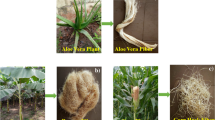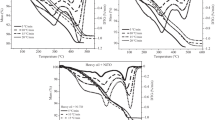Abstract
The widely used alkyd resin suffers not only the flammability but also the autoignition of resin waste. Its autoignition should result from the air-drying exothermic effect due to autoxidation and conversion of double bond. However, the air-drying exothermic effect is seldom studied. In this study, five soybean oil-based alkyd resins were synthesized. The content of double bond measured by the titration method increased linearly with increasing the molar fraction of maleic anhydride. After air-drying, the infrared spectroscopy absorption peak for the double bond disappeared. Considering that the curing originated from the conversion of chemical bonds, the exothermic effect was theoretically analyzed to be 1163–1455 kJ mol−1 double bond based on the air-drying mechanisms and the differences among chemical bond energies. According to thermodynamics principles, the air-drying exothermic effect was also derived from the measured heat of combustion. When the content of double bond increased from 2.19 mol kg−1 resin to 2.56 mol kg−1 resin, the exothermic effect linearly increased from 1352 kJ mol−1 double bond or 2.96 kJ g−1 resin to 2508 kJ mol−1 double bond or 6.42 kJ g−1 resin. The steady and unsteady autoignition theoretical analyses implied that due to the air-drying exothermic effect the alkyd resin waste with a certain thickness would catch fire within one working day.




Similar content being viewed by others
Abbreviations
- DB:
-
Amount of double bond in resin (mol kg−1)
- V :
-
Volume (L)
- C :
-
Concentration (mol L−1)
- m :
-
Mass (kg)
- ΔH r :
-
Heat of curing reaction (kJ g−1)
- ΔH C :
-
Heat of combustion (kJ g−1)
- δ :
-
Damkohler number
- θ :
-
Dimensionless temperature
- E :
-
Activation energy (kJ mol−1)
- R :
-
Gas constant
- k :
-
Heat conductivity (Wm−1 K−1)
- ρ :
-
Density (kg m−3)
- T :
-
Temperature (K)
- T cr :
-
Critical ignition temperature (K)
- r 0 :
-
Half thickness (mm)
- Q ’’’ :
-
Exothermic rate (kW m−3)
- t c :
-
Curing time (h)
- t ig :
-
Ignition time (h)
- α :
-
Thermal diffusivity (m2 s)
- C p :
-
Heat capacity (J kg−1 K−1)
References
Chardon F, Denis M, Negrell C, Caillol S. Hybrid alkyds, the glowing route to reach cutting-edge properties? Progress Org. Coatings. 2021;151:106025. https://doi.org/10.1016/j.porgcoat.2020.106025
Mellgren D, Scandinavian Star Survivors Mark Disaster Anniversary, April 7, 1991, https://apnews.com/article/10e97be5cc85ae4cd5beebcdf26afbb8.
Shahabudin N, Yahya R, Gan SN, Sonsudin F. Curing of epoxy/alkyd blends in self-healing coating. High Perform Polym. 2018;30(8):1009–15. https://doi.org/10.1177/0954008318784635.
Jovicic M, Radicevic R, Pavlicevic J, Bera O. Isoconversional kinetic analysis of the alkyd/melamine resins curing. Chem Ind Chem Eng Q. 2013;19(2):253–62. https://doi.org/10.2298/Ciceq111110059j.
Cakic SM, Ristic IS, Jaso VM, Radicevic RZ, Ilic OZ, Simendic JKB. Investigation of the curing kinetics of alkyd-melamine-epoxy resin system. Prog Org Coat. 2012;73(4):415–24. https://doi.org/10.1016/j.porgcoat.2011.03.016.
Radicevic R, Jovicic M, Budinski-Simendic J. Preparation and curing of alkyd based on ricinoleic acid/melamine coatings. Prog Org Coat. 2011;71(3):256–64. https://doi.org/10.1016/j.porgcoat.2011.03.008.
Jovicic MC, Radicevic RZ, Budinski-Simendic JK. Curing of alkyds based on semi-drying oils with melamine resin. J Therm Anal Calorim. 2008;94(1):143–50. https://doi.org/10.1007/s10973-008-9004-4.
Honzicek J, Vinklarek J. Chemical curing of alkyd resin catalyzed by benzoylferrocene: performance, kinetics, and thickness effects. J Appl Polym Sci. 2018;135(16):46184. https://doi.org/10.1002/app.46184.
Pirs B, Znoj B, Skale S, Zabret J, Godnjavec J, Venturini P. Iron as an alternative drier for curing of high-solid alkyd coatings. J Coat Technol Res. 2015;12(6):965–74. https://doi.org/10.1007/s11998-015-9724-x.
Bartolozzi G, Marchiafava V, Mirabello V, Peruzzini M, Picollo M. Chemical curing in alkyd paints: an evaluation via FT-IR and NMR spectroscopies. Spectrochim Acta A. 2014;118:520–5. https://doi.org/10.1016/j.saa.2013.09.017.
Poorabdollah M, Beheshty MH, Atai M, Vafayan M. Cure kinetic study of organoclay-unsaturated polyester resin nanocomposites by using advanced isoconversional approach. Polym Compos. 2013;34(11):1824–31. https://doi.org/10.1002/pc.22587.
Vinnik RM, Roznyatovsky VA. Kinetic method by using calorimetry to mechanism of epoxy-amine cure reaction–Part VII. Resorcinol diglycidylether-aniline. J Therm Anal Calorim. 2006;83(1):193–8. https://doi.org/10.1007/s10973-005-6955-6.
Vinnik RM, Roznyatovsky VA. Kinetic method by using calorimetry to mechanism of epoxy-amine cure reaction. Part VIII. A comparative study of some epoxy-amine reactions. J Therm Anal Calorim. 2006;85(2):455–61. https://doi.org/10.1007/s10973-005-7144-3.
de Boer JW, Wesenhagen PV, Wenker ECM, Maaijen K, Gol F, Gibbs H, et al. The quest for cobalt-free alkyd paint driers. Eur J Inorg Chem. 2013;2013(21):3581–91. https://doi.org/10.1002/ejic.201300205.
Simpson N, Maaijen K, Roelofsen Y, Hage R. The evolution of catalysis for alkyd coatings: responding to impending cobalt reclassification with very active iron and manganese catalysts, using polydentate nitrogen donor ligands. Catalysts. 2019;9(10):825. https://doi.org/10.3390/catal9100825
Funke W, Hoppe L, Hasselkus J, Curtis LG, Hoehne K, Zech H-J et al. Paints and Coatings, 2. Types. In: Ullmann's Encyclopedia of Industrial Chemistry. Wiley online (2010). https://doi.org/10.1002/14356007.o18_o01
Mironi-Harpaz I, Alperstein D, Knani D, Narkis M. Curing of styrene-free unsaturated polyester alkyd: synthesis, characterization and simulation. Polym Int. 2010;59(6):836–41. https://doi.org/10.1002/pi.2796.
Mironi-Harpaz I, Narkis M, Siegmann A. Curing of styrene-free unsaturated polyester alkyd and development of novel related clay nanocomposites. Macromol Symp. 2006;242:201–7. https://doi.org/10.1002/masy.200651028.
Erich SJF, Laven J, Pel L, Huinink HP, Kopinga K. NMR depth profiling of drying alkyd coatings with different catalysts. Prog Org Coat. 2006;55(2):105–11. https://doi.org/10.1016/j.porgcoat.2005.08.009.
Quintiere JG. Fundamentals of fire phenomena. England: Wiley; 2006.
DiNenno PJ. SFPE handbook of fire protection engineering. 3rd ed. Quincy, Massachusetts: National Fire Protection Association; 2002.
Acknowledgements
This work was supported by [National Natural Science Foundation of China] (Grant Number [51306097, 51906182]) and [Natural Science Foundation of Shandong Province, China] (Grant Number [ZR2019MEE114]).
Author information
Authors and Affiliations
Contributions
YW was involved in the conception of the work and the writing and revision of the manuscript. JZ, BZ, and YL were involved in the acquisition and analysis of data. JW and XJ were involved in the interpretation of data.
Corresponding author
Ethics declarations
Conflict of interest
There are no conflicts of interest/competing interests regarding the publication of this paper.
Additional information
Publisher's Note
Springer Nature remains neutral with regard to jurisdictional claims in published maps and institutional affiliations.
Rights and permissions
About this article
Cite this article
Wang, Y., Zhang, J., Zhao, B. et al. Dependence of the air-drying exothermic effect on the double bond in alkyd resins. J Therm Anal Calorim 147, 7785–7791 (2022). https://doi.org/10.1007/s10973-021-11084-8
Received:
Accepted:
Published:
Issue Date:
DOI: https://doi.org/10.1007/s10973-021-11084-8




